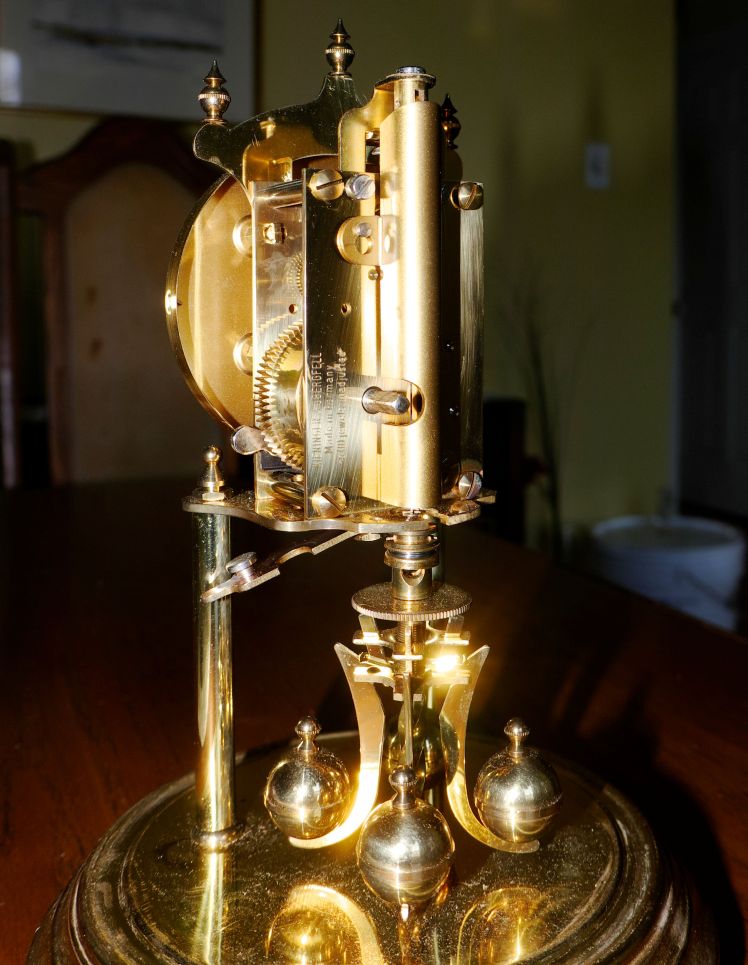My wife and I were at a little antique shop just outside Truro, Nova Scotia on a typical Sunday drive. I found a lovely Black Forest time-only shelf clock that was reasonably priced and bought it because it had a simple plate movement I was looking for. My wife on the other hand wandered through the same antique store and noticed a Kundo anniversary clock. Kundo was a well known German clock make and is otherwise known as Kieninger & Obergfell. Although we were not really in the market for an anniversary clock the price was right.
I noted at the time that it was not functioning but all it took when I got it home was a winding to get it running again and two weeks to regulate the time. Compared to those I have seen on EBay this one is in excellent condition and cleaned up well. The photos were taken prior to cleaning.

A 400 day anniversary clock is otherwise known as a torsion pendulum clock. The torsion clock is a mechanical clock which keeps time with a mechanism called a torsion pendulum. This is a weighted disk or wheel, often a decorative wheel with 3 or 4 chrome balls on ornate spokes, suspended by a thin wire or ribbon called a torsion spring (also known as suspension spring).

The torsion pendulum rotates about the vertical axis of the wire, twisting it, instead of swinging like an ordinary pendulum. The force of the twisting torsion spring reverses the direction of rotation, so the torsion pendulum oscillates slowly, clockwise and counterclockwise. The rotation is generally 270 to 360 degrees and takes about 7-9 seconds. Mine has a little bit of over-swing which is not problematic.
The clock’s gears apply a pulse of torque (provided by a winding spring) to the top of the torsion spring with each rotation to keep the wheel going. Because they are running so slowly and require little energy, they are capable of running for long periods but are not as accurate as weight driven or other spring driven clocks due to the fact that they are subject to temperature and humidity changes and the long run periods between windings augment any inaccuracy. Mine runs within 2-3 minutes a month and most would consider that to be acceptable.

An adjustment allows the balls to move in and out of its axis thereby controlling the rate of the clock. The closer the balls are to the centre of the axis the faster they will spin and further from the axis results in a slower rotation. Torsion clocks were popular gifts because they would run a year between windings thus marking an important occasion or anniversary.
Torsion clocks are usually delicate, ornamental, spring wound shelf clocks which typically stand between 9 and 12 inches in height. The polished clock mechanism is usually exposed under a plastic or glass case or dome (need not be, however), to allow one to watch the torsion pendulum turn.

This particular torsion clock was made in the 1970s. Shortly thereafter production of torsion clocks began to decline. There was a minor resurgence of electronically switched electro-mechanical (battery) torsion clocks but otherwise the age of the torsion clock was coming to an end.
Torsion clocks have a long history which I will explore in a future article.

Hey Ron,
I have an identical Kundo clock, as well as two “nearly identical” clocks which use the fancier stamped “repoussé” style dials. One was from my grandmother, and I believe one I picked up for around 15$ in a thrift shop. The third one was free (part of a trade). They are quite nice timepieces, but some are a lot nicer than others. I can’t stand the plastic ones, or battery powered versions. One or two of my Kundo clocks came with plastic domes, and I’ve been able to change or swap them with glass ones.
The only small “flaw” I noticed on yours is the loose pendulum lock lever. It’s the most visible in the last photo of your post. The lever should be a friction fit and flat against the bottom plate. It’s just a matter of tightening the screw or bolt that holds it in place.
One other quick mention: the suspension ribbons are temperature compensated, so technically they should keep relatively decent time, but most don’t.
LikeLike
Thanks JC. The photo was taken before I tightened that screw. I should have mentioned that in my entry. It is in great shape for a 40 year old clock. Did not know that the spring is temperature compensated.
LikeLike
I have been browsing online more than three hours lately, but I never found any fascinating article
like yours. It’s lovely price sufficient for me. Personally, if
all website owners and bloggers made good content material as you did, the web will be a lot more helpful than ever before.
LikeLike
Thanks for coming to my blog.
LikeLike
I couldn’t refrain from commenting. Exceptionally well written!
LikeLike
Thanks for dropping by.
LikeLike
It?s hard to find knowledgeable people on this topic, but you sound like you know what you?re talking about! Thanks
LikeLike